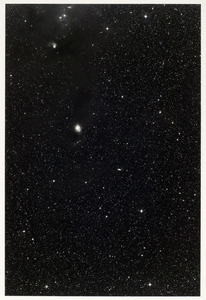Thomas Ruff has investigated a wide range of subject matter in his photographs, while maintaining a minimal authorial presence alongside the production of work in groups or series. Born in Zell-am-Harmersbach, he studied photography under Bernd Becher from 1977 to 1985. His early work consisted of color views of German apartments. These compact, minimalist interiors depicting the conventional details of everyday life reflect the influence of Bernd and Hilla Becher, and of such American photographers as Walker Evans and Stephen Shore, in their respect for the objects that constitute their subject matter.
Around 1981, Ruff began a series of formulaic portraits of fellow art students that consistently frame the sitter within an institutionalized format appropriated from passport, police, and commercial studio photographs. In the earlier, smaller portraits, the sitter could choose from among several plain colored backdrops, and was positioned frontally, in profile, or with a three-quarter view. The equivalence of these portraits is underscored by their even lighting, and by their uniform title, Portrait, signaling a typology recalling the work of August Sander. Ruff's portraits, however, do not attempt to document social classification, since they draw on a relatively homogeneous population. They emphasize sameness rather than individual distinction and, in their impassivity, tend toward abstraction as they resist interpretation or identification. In 1986, Ruff shifted the scale of the portraits, making dramatic, larger-than-life prints. Their almost cinematic presence is nevertheless confounded by the persistently ordinary people depicted. Concurrent with the portraits, Ruff has rephotographed ten years' worth of clipped newspaper reproductions, printing them at twice their original scale. The emotional and pictorial flatness characteristic of Ruff's work are otherwise deployed in his Stars series, begun around 1990. Enlarged from negatives found in an observatory to a physically overwhelming vertical orientation of up to seven feet tall, their inestimable depth flattens out to pure photographic surface.
Lisa Soccio
Handy et al. Reflections in a Glass Eye: Works from the International Center of Photography Collection, New York: Bulfinch Press in association with the International Center of Photography, 1999, p. 226.



